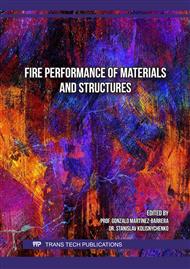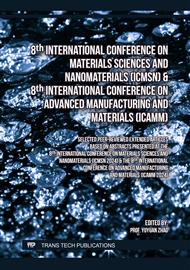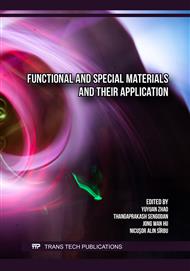[1]
M. Derradji, O. Mehelli, N. Fantuzzi, Sustainable and Ecofriendly Chemical Design of High Performance Bio-Based Thermosets for Advanced Applications, Frontiers in Chemistry 9 (2021).
DOI: 10.3389/fchem.2021.691117
Google Scholar
[2]
M.A. Hillmyer, The promise of plastics from plants, Science 358(6365) (2017) 868-870.
DOI: 10.1126/science.aao6711
Google Scholar
[3]
M. Derradji, W. Jun, L. Wenbin, Phthalonitrile resins and composites : properties and applications, William Andrew Applied Science Publishers, an imprint of Elsevier, Oxford, United Kingdom, 2018.
Google Scholar
[4]
X.Y. Yu, K. Naito, C. Kang, X.W. Qu, Q.X. Zhang, Synthesis and properties of a high‐temperature naphthyl‐based phthalonitrile polymer, Macromolecular Chemistry and Physics 214(3) (2013) 361-369.
DOI: 10.1002/macp.201200492
Google Scholar
[5]
A.Q. Dayo, A.-r. Wang, M. Derradji, S. Kiran, A. Zegaoui, J. Wang, W.-b. Liu, Copolymerization of mono and difunctional benzoxazine monomers with bio-based phthalonitrile monomer: Curing behaviour, thermal, and mechanical properties, Reactive and Functional Polymers 131 (2018) 156-163.
DOI: 10.1016/j.reactfunctpolym.2018.07.022
Google Scholar
[6]
K.H. Miean, S. Mohamed, Flavonoid (myricetin, quercetin, kaempferol, luteolin, and apigenin) content of edible tropical plants, Journal of agricultural and food chemistry 49(6) (2001) 3106-3112.
DOI: 10.1021/jf000892m
Google Scholar
[7]
L. Jurd, Plant polyphenols. V. Selective alkylation of the 7-hydroxyl group in polyhydroxyflavones, Journal of the American Chemical Society 80(20) (1958) 5531-5536.
DOI: 10.1021/ja01553a054
Google Scholar
[8]
S. Soudjrari, M. Derradji, B. Amri, K. Djaber, O. Mehelli, S. Tazibet, S. Abdous, N. Ramdani, W. Liu, A. Khadraoui, Novel vanillin-based benzoxazine containing phthalonitrile thermosetting system: Simple synthesis, autocatalytic polymerization and high thermomechanical properties, High Performance Polymers 34(7) (2022) 818-827.
DOI: 10.1177/09540083221088738
Google Scholar
[9]
A. Berrouane, M. Derradji, K. Khiari, O. Mehelli, A. Habes, S. Abdous, B. Amri, M.E.A. Kadi, W. Liu, Sustainable synthesis of a novel bio-based low temperature curable benzoxazine monomer from quercetin: Synthesis, curing reaction and thermal properties, High Performance Polymers 0(0) 09540083231206532.
DOI: 10.1177/09540083231206532
Google Scholar
[10]
M. Xu, M. Liu, S. Dong, X. Liu, Design of low temperature self-cured phthalonitrile-based polymers for advanced glass fiber composite laminates, Journal of Materials Science 48 (2013) 8108-8116.
DOI: 10.1007/s10853-013-7623-z
Google Scholar
[11]
Y. Zu, G. Li, L. Zong, L. Qiao, J. Wang, X. Jian, Branched phenyl‐s‐triazine moieties to enhance thermal properties of phthalonitrile thermosets, Polymer International 67(2) (2018) 189-196.
DOI: 10.1002/pi.5494
Google Scholar
[12]
Z. Chen, H. Guo, H. Tang, X. Yang, M. Xu, X. Liu, Preparation and properties of bisphenol A‐based bis‐phthalonitrile composite laminates, Journal of Applied Polymer Science 129(5) (2013) 2621-2628.
DOI: 10.1002/app.38986
Google Scholar




